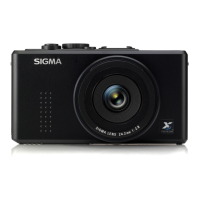Bigger Sensor — Better Image Quality
Film or digital: big photoreceptors
mean high image quality.
The bigger the film size, the better
the image quality. That's common
knowledge in the world of film
cameras. Even so, caught up in the
powerful tide of digitization, and the
feverish, single-minded competition to
achieve the highest pixel count, most
camera manufacturers seem to have
lost sight of this obvious fact some
time ago. Ever tried using a Brownie
film camera to shoot high-quality
photos? Then you'll have a vivid sense
of the exponential increase in image
quality as film size increases. Basically,
the same goes for digital cameras. In
other words, sensor performance being
equal, the image quality of a digital
camera is determined by the size of
the image sensor, be it CCD, CMOS or
any other type.
In the era of film cameras, both SLRs
and compacts using the 35mm system
used the same size of film, and image
quality was down to lens performance.
There used to be compact film cameras
that delivered high image quality
despite their small body size, and
those compacts had a large following
among photographers. When cameras
made the switch from film to digital,
however, it was taken for granted that
DSLRs and digital compacts would use
different image sensors.
The digital camera of anyone's dreams
Implementing a large sensor presented
all sorts of problems: the cost of the
sensor, the difficulty of designing the
lens, the high processing capacity
required for the image-processing
engine, enlarging the circuit board,
increasing the memory capacity, and
so on. Until these problems could be
overcome, it was generally accepted
that DSLRs used large sensors, and
compacts used small ones. Eventually,
these problems were effectively solved,
allowing sensors to be made smaller.
However, this involved a trade-off:
reduced image quality. From then on,
photographers dreamed of a compact
digital camera with an SLR-sized
image sensor. A camera small and light
enough to carry around everywhere,
yet offering the technology for serious
photography. Those dreams came true
with Sigma's DP series.
Startlingly evocative image quality
At 20.7 x 13.8mm, the DP1x's
14-megapixel image sensor, like the
DP1's, is SLR-sized. This is about 12
times larger than the 1- to 2.5-inch
sensor, and 7 times larger than a 1- to
1.8-inch sensor used in a conventional
digital compact. This generous size
takes the DP1x's image quality to a
different dimension.
Picture this. Light traveling through
a small lens is captured by a small
sensor and turned into an image.
Light traveling through a large lens
is captured by a large sensor and
turned into an image. What's the
difference between these two images?
Essentially, it's a difference in quality.
In the case of the small image sensor,
the image is magnified by a high ratio
when it's printed or displayed on a
computer screen. This makes it tricky
to reproduce the dynamism and 3-D
feel of the subject. Like the other DP
cameras, the DP1x does just that, by
using a large integral image sensor.
The natural blurring effect
you get with an SLR.
The small size of the image sensor
used in a conventional compact digital
camera explains why it captures rather
flat, unmodulated images. If the image
sensor is small, the focal length of
the lens is short. The shorter the focal
length of the lens, the greater the depth
of field – in other words, the greater
the range of distances over which the
SIGMA DP1x's Direct Image Sensor
Conventional
Compact
Digital Camera's
Image Sensor
The DP1x has an integral 14 megapixel,
SLR-sized (20.7 x 13.8mm) image
sensor. This is about 12 times larger
than 1- to 2.5-inch sensor, and 7 times
larger than a 1- to 1.8-inch sensor used
in a conventional compact digital
camera. This generous size takes the
DP1x's image quality to a different
dimension. What's more, the pixel
pitch of the image sensor is a generous
7.8μm. An ordinary compact digital
camera delivers “high quality” with a
high pixel count achieved simply by
dividing up the sensor into smaller
sections. In the DP1x, however, the large
photodiodes deployed at a large pixel
pitch capture pure, rich light efficiently,
so the image signal is superb right from
the start. This gives the DP1x its high
resolution and richly graduated tones.
Image Sensor Size Comparison
lens can focus. The prosaic quality of
the images captured by an ordinary
compact digital camera is caused by
the depth of field characteristic of a
small image sensor: the lens focuses
evenly on everything between the
subject and the background, eliminating
any cadence within the image. Thanks
to its DSLR sized sensor, the DP1x can
achieve SLR-worthy natural blurring
effects, even at an aperture of F4.
Images of this astonishing quality and
richness are only possible with a large
sensor. You really need to see them
for yourself.
16

